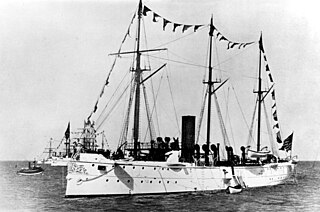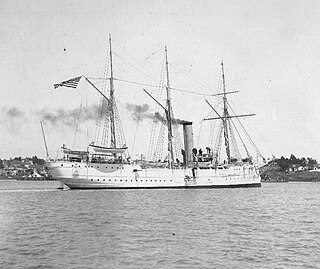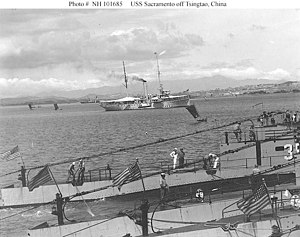
USS New York (ACR-2/CA-2) was the second United States Navy armored cruiser so designated; the first was the ill-fated Maine, which was soon redesignated a second-class battleship. Due to the unusually protracted construction of Maine, New York was actually the first armored cruiser to enter U.S. Navy service. The fourth Navy ship to be named in honor of the state of New York, she was later renamed Saratoga and then Rochester. With six 8-inch guns, she was the most heavily armed cruiser in the US Navy when commissioned.

The third USS Albany was a United States Navy protected cruiser of the New Orleans class. She saw service in the Philippine–American War and World War I.

USS Bennington was a member of the Yorktown class of steel-hulled, twin-screw gunboats in the United States Navy in the late 19th and early 20th centuries. She was the first U.S. Navy ship named in honor of the town of Bennington, Vermont, site of the Battle of Bennington in the American Revolutionary War.

USS Dolphin (PG-24) was a gunboat/dispatch vessel; the fourth ship of the United States Navy to share the name. Dolphin's keel was laid down by Delaware River Iron Ship Building and Engine Works of Chester, Pennsylvania. She was launched on 12 April 1884, with Captain George Dewey in command, and commissioned on 8 December 1885 with Captain R. W. Meade in command. Dolphin was the first Navy ship to fly the flag of the president of the United States during President Chester A. Arthur's administration, and the second Navy ship to serve as a presidential yacht.

USS Whipple, a Clemson-class destroyer was the second ship of the United States Navy named in honor of Captain Abraham Whipple (1733–1819), who served in the Continental Navy.

USS Raleigh (C-8) was a United States Navy protected cruiser of the Cincinnati class, commissioned in 1894 and in periodic service until 1919.

USS Yorktown was lead ship of her class of steel-hulled, twin-screw gunboats in the United States Navy in the late 19th and early 20th centuries. She was the second U.S. Navy ship named in honor of the American Revolutionary War's Battle of Yorktown.

USS Pampanga (PG-39) was a schooner-rigged iron gunboat in the United States Navy during the Philippine–American War. She retained her Spanish name.

USS Stewart (DD-224) was a Clemson-class destroyer in the United States Navy during World War II. She was the second ship named for Rear Admiral Charles Stewart. Scuttled in port at Surabaya, Java, she was later raised by the Japanese and commissioned as Patrol Boat No. 102. She came back under American control in 1945 after the occupation of Japan.

USS Nashville (PG-7), a gunboat, was the only ship of its class. It was the first of three ships of the United States Navy to hold the name Nashville.

USS Isabel (SP-521), later PY-10, was a yacht in commission in the United States Navy as a destroyer from 1917 to 1920 and as a patrol yacht from 1921 to 1946.

USS Wheeling (PG-14) was a Wheeling-class gunboat acquired by the U.S. Navy in 1897. She served as a gunboat during the Spanish–American War as well as a convoy escort during World War I. As IX-28 she also served as a schoolship for the training of Naval Reservists, and, at the end of World War II, just before being struck from the Navy records, she was temporarily assigned as a barracks ship for torpedo boat crews.

USS Concord was a member of the Yorktown class of steel-hulled, twin-screw gunboats in the United States Navy in the late 19th and early 20th centuries. She was the second U.S. Navy ship named in honor of the town of Concord, Massachusetts, site of the Battle of Concord in the American Revolutionary War.

The first USS Machias (PG-5), a schooner-rigged gunboat, was laid down in February 1891 by Bath Iron Works, Bath, Maine. She was launched on 8 December 1891. She was sponsored by Miss Ethel Hyde, daughter of President Hyde of Bath Iron Works and commissioned at Portsmouth Navy Yard, Kittery, Maine, 20 July 1893, Commander Charles J. Train in command.

USS Wilmington (PG-8) was the lead ship in a class of two United States Navy gunboats. She was laid down on 8 October 1894 at Newport News, Virginia, by the Newport News Shipbuilding Company; launched on 19 October 1895; sponsored by Mrs. Anne B. Gray; and commissioned on 13 May 1897.

USS Fulton (AS-1) was constructed as a submarine tender in 1914, but later was converted into a gunboat and redesignated PG-49.

USS McCulloch, previously USRC McCulloch and USCGC McCulloch, was a ship that served as a United States Revenue Cutter Service cutter from 1897 to 1915, as a United States Coast Guard Cutter from 1915 to 1917, and as a United States Navy patrol vessel in 1917. She saw combat during the Spanish–American War during the Battle of Manila Bay and patrolled off the United States West Coast during World War I. In peacetime, she saw extensive service in the waters off the U.S. West Coast. She sank in 1917 after colliding with another steamer.

The Yorktown class was a class of three steel-hulled, twin-screw gunboats built for the United States Navy beginning in 1887. All three ships of the class were named after cities near American Revolutionary War battles.

The Montgomery-class cruisers were three unprotected cruisers built for the United States Navy in the early 1890s. They had a thin water-tight protective deck, and also relied for protection upon their coal bunkers, cellulose packing, and numerous compartments. Roomy accommodations were provided for officers and crew, these cruisers being mainly intended for long cruises on distant stations.

The Asheville-class gunboat was a class of two gunboats, USS Tulsa and USS Asheville, which was based on Sacramento, an earlier gunboat. Laid down between 1917 and 1919, construction was completed in the early 1920s after which both ships were employed to project US naval power across several different theaters, including Central America and the Pacific, during the interwar years. Tulsa principally served in Asia, assigned variously with the South China Patrol, Yangtze Patrol, and the Inshore Patrol; Asheville mostly stayed in Central America, but did spend a few years on the South China Patrol alongside Tulsa. When war broke out with Japan in the Pacific, both ships were used to escort convoys. Asheville was lost during the war, but Tulsa survived to be broken up in the late 1940s. The class was awarded a total of three battle stars, one for Asheville and two for Tulsa.




















